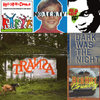The History of Red Hot, the Pioneering Social Change Organization, in 8 Great Songs
Ahead of ‘Transa,’ a new project for trans charities featuring Sade and André 3000, Red Hot founder John Carlin talks about wrangling Nirvana through Kurt Cobain’s babysitter and accidentally releasing the first-ever Wilco song.

On November 22, the Red Hot Foundation will release Transa, a project benefiting charities for trans folks like GLITS and the Sylvia Rivera Law Project. As with the last 34 years of Red Hot albums, it’s full of inventive musical pairings and ideas. Transa’s 46 tracks include collaborations between pop star Sam Smith and the new age innovator Beverly Glenn-Copeland, Wilco leader Jeff Tweedy and emo ambient artist Claire Rousay, singer-songwriter Helado Negro and the poet Eileen Myles, and experimental saxophonist Cole Pulice and actress Hunter Schaefer, among many others. There are choice Prince and Sylvester covers, and brand new tracks from André 3000 and Sade, who contributed a song she wrote for her son, Izaak Theo Adu, who is trans. Red Hot albums always feel like events, and Transa is no exception.
The album’s focus on trans rights bittersweetly mirrors the Red Hot Foundation’s original mission. When the non-profit was founded in 1989, AIDS was the leading cause of death for young people in New York City. That year alone in the city, 19,494 people died from AIDS, and 29,807 people received new diagnoses. Like many people living in New York at that time, the art writer and curator turned entertainment lawyer John Carlin saw friends and acquaintances living one day and gone the next. He was angry, and wanted to do something about it.
So he got together with Leigh Blake, a filmmaker he knew, and began compiling Red Hot + Blue, a charitable compilation album featuring artists like Sinead O’Connor, the Jungle Brothers, and Neneh Cherry covering classic Cole Porter songs. Red Hot + Blue earned $1 million for ACT UP. Its accompanying ABC special—a collection of PSAs and videos by directors like Jonathan Demme, Wim Wenders, and Jim Jarmusch—featured Richard Gere, then the most beloved actor in America thanks to Pretty Woman, advising primetime viewers to wear condoms and stop sharing needles to prevent the spread of HIV.
It is hard to capture how groundbreaking this was at the time, when homophobia was rampant in culture and government, and AIDS was still spoken about in the media with hushed, otherizing tones. But transphobia in the U.S. today provides a shameful parallel, as the demonization of trans folks echoes the way gays and lesbians were scapegoated for all societal ills in the 1980s and ’90s. Transa is a spiritual counterpart to the original Red Hot + Blue, both groundbreaking and necessary.
I spoke with Carlin about Transa and his three decades of working with some of the world’s most innovative musicians. Below, he tells the history of Red Hot through a few of the compilations’ greatest songs.





